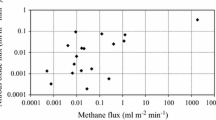Abstract
The N2O content of waters in the Potomac and Merrimack Rivers was measured on a number of occasions over the period April to July 1977. The concentrations of dissolved N2O exceed those which would apply in equilibrium with air by factors ranging from about 46 in the Potomac to 1.2 in the Merrimack. Highest concentrations of dissolved N2O were associated with sewage discharges from the vicinity of Washington, D.C. and analysis indicates a relatively high yield, 1.3 to 11 percent, for prompt conversion of waste nitrogen to N2O. The yield could be even higher if bubbles originating in sediments should contain as little as 0.3 percent N2O. Measurements of dissolved N2O in fresh water ponds near Boston demonstrate that aquatic systems may provide both strong sources and sinks for atmospheric N2O.
Similar content being viewed by others
References
Bates, D. R. andHays, P. B. (1967),Atmospheric nitrous oxide, Planet. Space Sci.15, 189.
Bates, D. R. andWitherspoon, A. E. (1952),The photo-chemistry of some minor constituents of the earth's atmosphere, Mon. Not. Roy. Astron. Soc.112, 101.
Broecker, W. S. andPeng, T. H. (1974),Gas exchange rates between air and sea, Tellus26, 21.
Crutzen, P. J. (1970),The influence of nitrogen oxides on the atmospheric ozone content, Quart. J. Roy. Meteor. Soc.96, 320.
Crutzen, P. J. (1971),Ozone production rates in an oxygen-hydrogen-nitrogen atmosphere, J. Geophys. Res.76, 7311.
Crutzen, P. J. (1974),Estimates of possible variations in total ozone due to natural causes and human activities, Ambio3, 201.
Deevey, E. S., Jr., Mineral cyclesin The Biosphere, (W. H. Freeman and Co., San Francisco 1970) 81 pp.
Elkins, J. W., Kaplan, W., Kolb, C. E., McElroy, M. B. andWofsy, S. C. (1977),Determination of spring 1977 water column and marine air nitrous oxide concentrations in the New York Blight, Aerodyne Res. Inc., Tech. Rep. #ARI-RR-109, June 1977, Bedford, Mass.
Emerson, S. (1975),Gas exchange rates in small Canadian Shield lakes, Limnol. Oceanog.20, 754.
Fortescue, G. E. andPearson, J. R. A. (1967),On gas absorption into a turbulent liquid, Chem. Eng. Sci.22, 1163.
Hammond, D. E., Simpson, H. J. andMathieu, G. (1975),Methane and Radon-222 as tracers for mechanisms of exchange across the sediment-water interface in the Hudson River estuary, in marine chemistry in the coastal environment, Amer. Chem. Soc. Symp. Ser. 18 (ed. T. M. Church) American Chemical Society, 119 pp.
Johnston, H. S. (1971),Reduction of stratospheric ozone by nitrogen oxide catalysts from supersonic transport exhaust, Science173, 517.
Markham, A. E. andKobe, K. A. (1941),Solubility of carbon dioxide and nitrous oxide in salt solution. J. Amer. Chem. Soc.63, 449.
McAuliffe, C. (1969),Determination of dissolved hydrocarbons in subsurface brines, Chem. Geol.4, 225.
McAuliffe, C. (1971),G. C. determination of solutes by multiple phase equilibrium, Chem. Tech.46 (Jan. 71).
McElroy, M. B. (1974), Testimony presented to the Committee on Interstate and Foreign Commerce, U.S. House of Representatives, Washington D.C. 11 December 1974.
McElroy, M. B.,Chemical processes in the solar system: A kinetic perspective inMTP International Review of Science, Series Two, Volume 9 (ed. D. R. Herschback) Butterworths, London 1975) 127 pp.
McElroy, M. B. andMcConnell, J. C. (1971),Nitrous oxide: A natural source of stratospheric NO, J. Atmos. Sci.28, 1095.
McElroy, M. B., Wofsy, S. C. andYung, Y. L. (1977),The nitrogen cycle: Perturbations due to man and their impact on atmospheric N 2 O and O 3 Phil. Trans. Roy. Soc., B,277, 159.
National Academy of Sciences,Accumulation of Nitrate (National Academy of Sciences, Washington, D.C. 1972), 106 pp.
National Academy of Sciences,World Food and Nutrition Study, the Potential Contributions of Research (National Academy of Sciences, Washington, D.C. 1977), 192 pp.
Nicolet, M. andVergison, A. (1971),L'oxyde azoteux dans la stratosphere, Aeron. Acta.90, 1.
Pierotti, D. andRasmussen, R. A. (1976),Combustion as a source of nitrous oxide in the atmosphere, Geophys. Res. Lett.3, 615.
Swinnerton, J. W., Linnenbom, V. J. andCheek, C. H. (1967),Distribution of methane and carbon monoxide between atmosphere and natural waters, Envi. Sci. Tech.3, 836.
Weiss, R. F. andCraig, H. (1976),Production of atmospheric nitrous oxide by combustion, Geophys. Res. Lett.3, 751.
Author information
Authors and Affiliations
Rights and permissions
About this article
Cite this article
Kaplan, W.A., Elkins, J.W., Kolb, C.E. et al. Nitrous oxide in fresh water systems: An estimate for the yield of atmospheric N2O associated with disposal of human waste. PAGEOPH 116, 423–438 (1978). https://doi.org/10.1007/BF01636897
Received:
Issue Date:
DOI: https://doi.org/10.1007/BF01636897




